How to remove rust from metal furniture, the 10 BEST WAYS. Using common items from your garage or pantry & TIPS to restore metal furniture.
How To Remove Rust From Metal Furniture
Stop throwing out that rusty furniture. There are so many easy ways to get rust off metal furniture and restore it to LIKE NEW condition.
I have 10 proven ways to remove rust from metal furniture, metal parts, and tools. Some of these work faster than others. Some of them are better for small items like tools.
Others are best for big jobs and heavy rust. Let’s get into it and I’ll give you some DIY tips for removing rust from metal to help you get the job done.
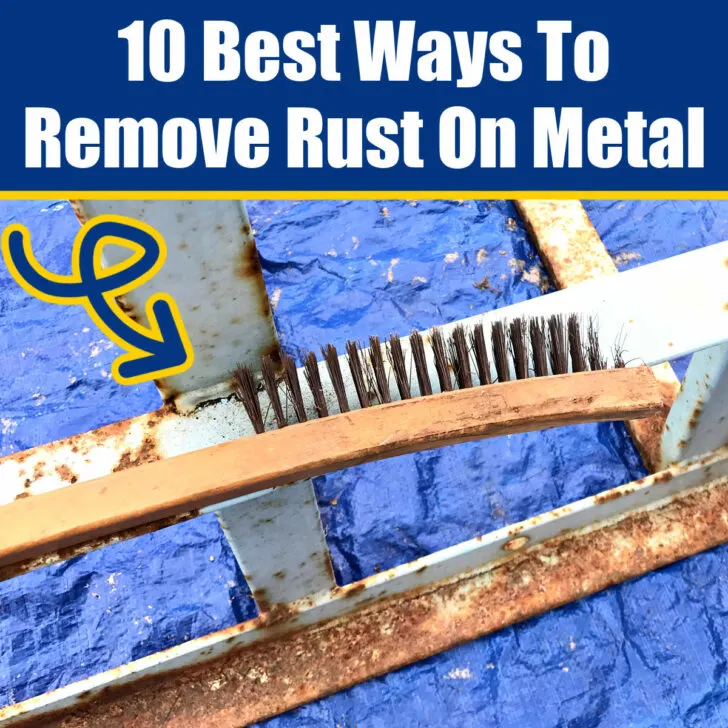
Table of contents
- How To Remove Rust From Metal Furniture
- 10 Best Ways To Remove Rust From Metal
- 1. Using A Stiff Bristle Brush To Remove Rust
- 2. Using Vinegar To Remove Rust From Metal
- 3. Using Wire Brushes And Wheels To Remove Rust
- 4. Using Baking Soda and Hydrogen Peroxide To Remove Rust
- 5. Using Evapo-Rust Rust Remover On Rusty Metal
- 6. Using Limes Or Lemons And Salt To Remove Rust From Metal
- 7. Use Citric Acid To Remove Rust From Metal
- 8. Using Oxalic Acid To Get Rid Of Rust On Metal
- 9. Use Angle Grinder Stripping Discs On Rust
- 10. Using Diesel To Remove Rust on Tools and Metal
- How To Protect Metal After Removing Rust From Metal
- How To Restore Rusted Metal Holes, Dents, and Damage
- How to Paint Rusty Metal Furniture
10 Best Ways To Remove Rust From Metal
Before we get started, I want to say there are even more ways than this to remove rust from metal. But, these are the top ones I’ve tried or seen used.
Some of the other tricks for removing rust from metal I avoid because they’re too messy, like using ketchup, or they use chemicals that aren’t safe on skin, so I’d rather not mess with those.
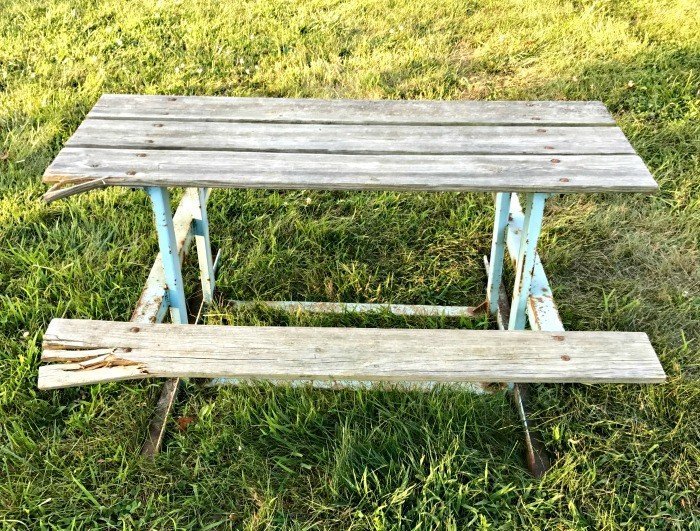
This little picnic table is so sweet. Who wouldn’t want to save it, right?! Let’s get started with how to get rust off metal.
1. Using A Stiff Bristle Brush To Remove Rust
Grab that stiff bristle, wire brush and a bucket of soapy water to scrub every inch of that metal. Remove as much rust as possible. This will require more physical effort than most of the other ways to remove rust.
It’s really important to remove all of the loose and flaky bits before you paint rusty metal furniture. Then rinse the metal clean and completely towel dry to avoid starting new rust growth.
You can see an example of a good steel wire brush on Amazon here. Here’s a set of steel wire brushes in different sizes, great for reaching tough spots. Neither is expensive.
You can also follow that scrubbing up with an acidic wash with something like white vinegar or citric acid to be really sure that the rust has been removed and it’s ready for paint.
2. Using Vinegar To Remove Rust From Metal
Vinegar is great at removing rust from metal. But, it needs to be left on the metal for a while to work. If your rusty metal is small, like a tool, you can submerge it in vinegar for a few hours.
If you need to remove rust on larger items, like rusty outdoor furniture, soak rags or paper towels in vinegar. Then wrap them or place them on the rusted metal.
Follow that up by wrapping the rags or towels with foil or plastic bags to hold the soaked rags in place. That will also stop the rags from drying out, so the vinegar can work longer.
After a few hours of soaking the rust in vinegar, you should be able to easily remove any visible rust with a little steel wool. Or, wad up some aluminum foil to scrub that loosened rust off.
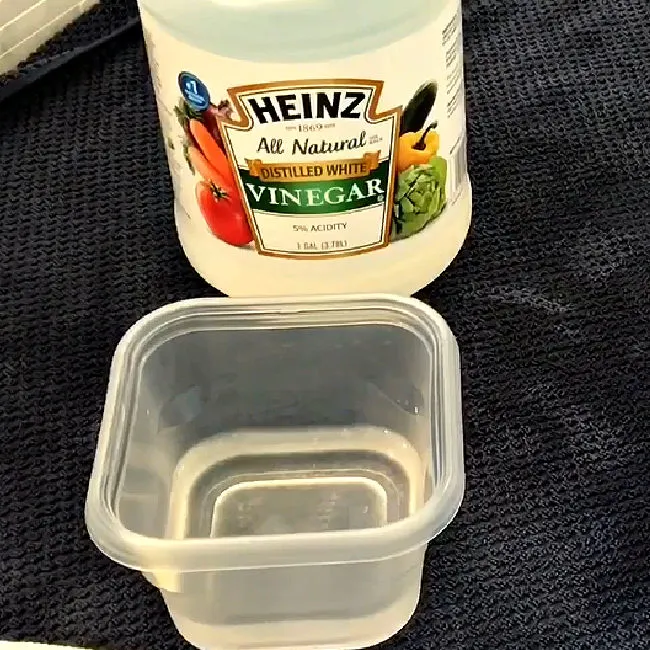
3. Using Wire Brushes And Wheels To Remove Rust
You can also use a wire brush and/or wire wheels with your drill to quickly restore that rusty metal furniture to it’s original, rust-free metal look.
And, one of the benefits of using wire brushes is that it’s a lot less physical labor than scrubbing it by hand. Wire brushes and wheels are one of the best solutions for heavily rusted metal.
This set of wire brushes comes in different shapes and sizes, perfect for large spots and hard to reach spaces.
4. Using Baking Soda and Hydrogen Peroxide To Remove Rust
For smaller patches you can clean rust off metal by mixing Baking Soda into a paste with a little Hydrogen Peroxide. Apply that paste to the rust and let it sit for an hour or two.
Then scrub away all that rust with a Heavy-Duty Scrubbing Pad or a little steel wool. Rinse it clean with fresh water, then dry completely.
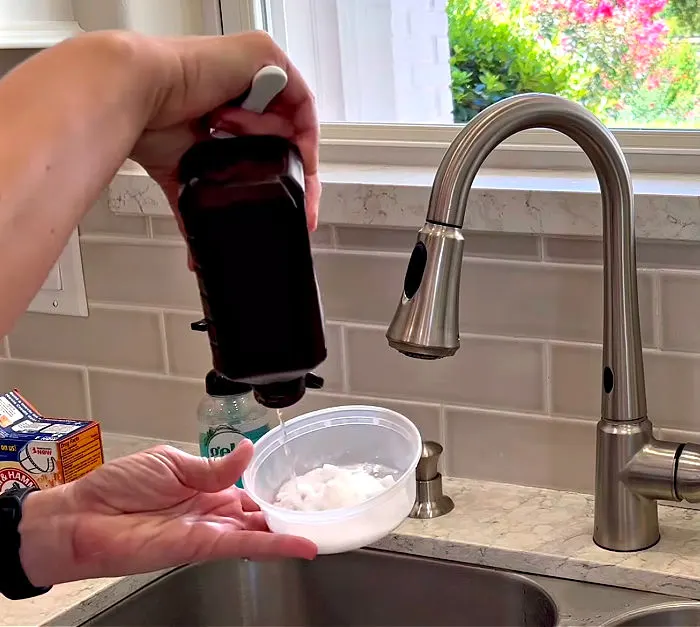
5. Using Evapo-Rust Rust Remover On Rusty Metal
Evapo-Rust is often voted one of the TOP rust removers available in stores. Not only does it work amazingly well. It’s also an incredibly safe way to remove rust without much effort.
Evapo-rust is non-toxic, biodegradable, water-soluble, non-corrosive, reusable, and pH neutral. It also has NO VOC’s, fumes, or acids. And, is safe on skin and eyes. Incredible, right?!
To use Evapo-rust, submerge the rusted metal in it or cover the rusted metal with a layer of it. Wait for the rust to be removed, then rinse with water, and dry completely.
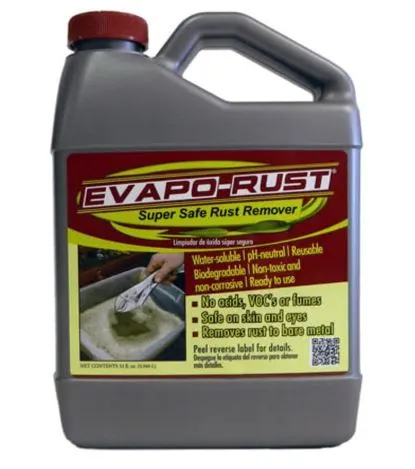
6. Using Limes Or Lemons And Salt To Remove Rust From Metal
The acids in limes and lemons are great at removing rust from metal. BUT, you’d have to squeeze a lot of them for large rust spots. So this one is best for small rust spots.
To remove rust with lemons and limes, sprinkle the rust spot with a nice layer of salt. Then squeeze enough juice onto the rust spot to complete cover it. Leave it in place for a few hours to remove the rust.
The salt is coarse enough to help you scrub any residue off. And, it’ll help hold the juice in place, instead of spreading out. You could also use a cotton ball soaked in juice to keep the juice on the rust spot.
7. Use Citric Acid To Remove Rust From Metal
Instead of using fresh lemons or limes, you can get the same result with store-bought Citric Acid. You can usually find Citric Acid in the baking section of your grocery store.
Mix the Citric Acid with some hot water. You can soak the small rusty metal items in the mixture. Or, to remove rust from metal furniture, saturate rags or paper towels in the mixture.
Wrap the saturated rags around the furniture. Then wrap them in plastic or foil to keep them wet while the acid penetrates the rust. This method might take 24 hours or more for tough rust.
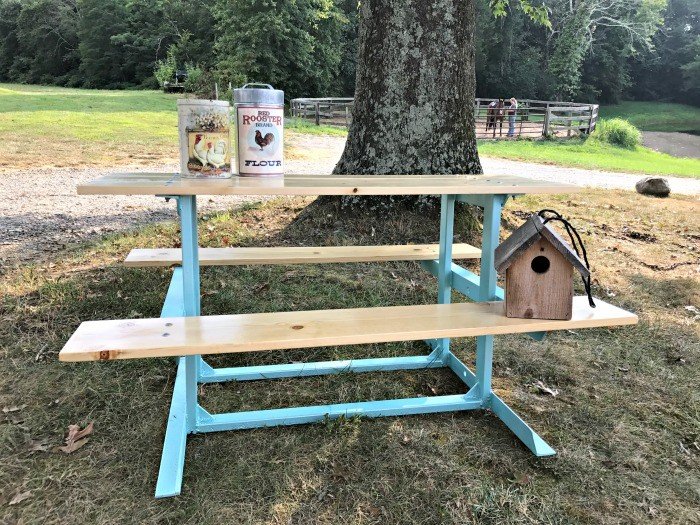
8. Using Oxalic Acid To Get Rid Of Rust On Metal
This might sound strange, but it really works! Peeled raw potatoes contain Oxalic Acid. Oxalic Acid can get rid of rust on metal.
You can get the best results by sprinkling that raw potato with some salt or baking soda (for grit), then scrub the rust spots with that salted potato. You can leave a rusty knife in a potato to safely and easily remove rust on sharp blades.
If you don’t have a potato, Barkeepers Friend is mostly made of Oxalic Acid. So, mix a bit of it with water to scrub rust off metal. You can use a wire brush or abrasive sponge with the Barkeepers Friend.
Using the potato method or Barkeepers Friend would probably be best to get rid of rust on metal cookware, hand tools, or small rust spots on metal furniture. It’s not practical for large-scale rust removal.
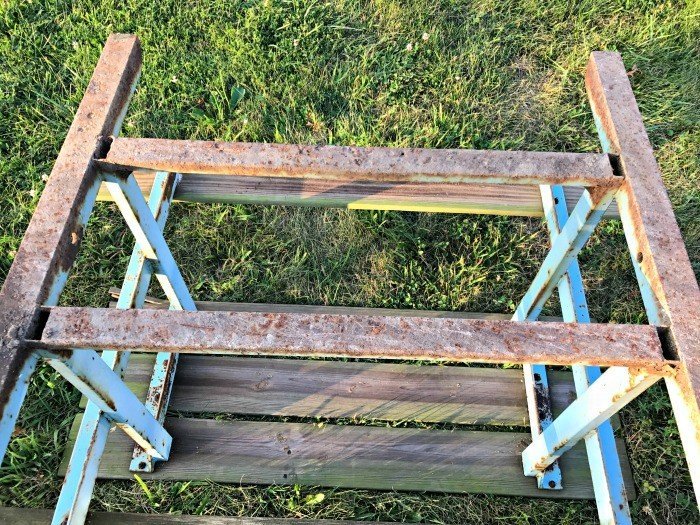
9. Use Angle Grinder Stripping Discs On Rust
An Angle Grinder is another great tool that can be used to grind off the rust from metal to expose bare metal. Angle Grinders are another one of the best solutions for heavily rusted metal.
The Angle Grinder can also be used to smooth metal surfaces after the rust was removed with one of the other ways to remove rust off metal.
Just be sure to wear safety glasses and follow all safety instructions when using an Angle Grinder.
10. Using Diesel To Remove Rust on Tools and Metal
Last but not least, you can soak rusty metal tools and parts in Diesel to remove the rust. This is an old-fashioned, proven way to remove rust that my Grandpa always used.
Let the rusty metal soak for 24 hours in the Diesel, then scrub it clean with a brass brush. Finish by rubbing the tool dry with an old rag.
You can store that Diesel for the next time you need to clean rust off metal.

How To Protect Metal After Removing Rust From Metal
Unprotected Iron and Steel will begin to rust as soon as they are exposed to air. Other metals rust with contact with water or humidity. So, be sure to apply some sort of protector right away.
Here are a few good ways to protect metal after removing rust.
- You can use a metal primer to seal the metal and protect it from rusting. Something like Rust-Oleums Rusty Metal Primer or Krylons Rusty Metal Primer.
- You can apply a Paint & Primer In One Spray Paint made for metal.
- Use a Clear Coat Spray made for metal.
- You can apply WD-40 to metals that only get lightly rusted, like tools, to protect them.
- For stainless steel pans and other cookware, always dry them directly after washing. Then store them in a dry, humid-free location.

How To Restore Rusted Metal Holes, Dents, and Damage
If you have rust holes in the metal to repair, use something like Bondo. Bondo dries hard and strong, it’s even used by mechanics in auto body repair.
I have a tutorial for how to use Bondo to fix damaged wood furniture and the steps are the same with metal. Just mix and apply. Or, just follow the directions on the Bondo container.
Optional: If you want the metal to look perfectly smooth again, you can use a wire wheel on a drill OR an angle grinder to smooth the rusted metal.
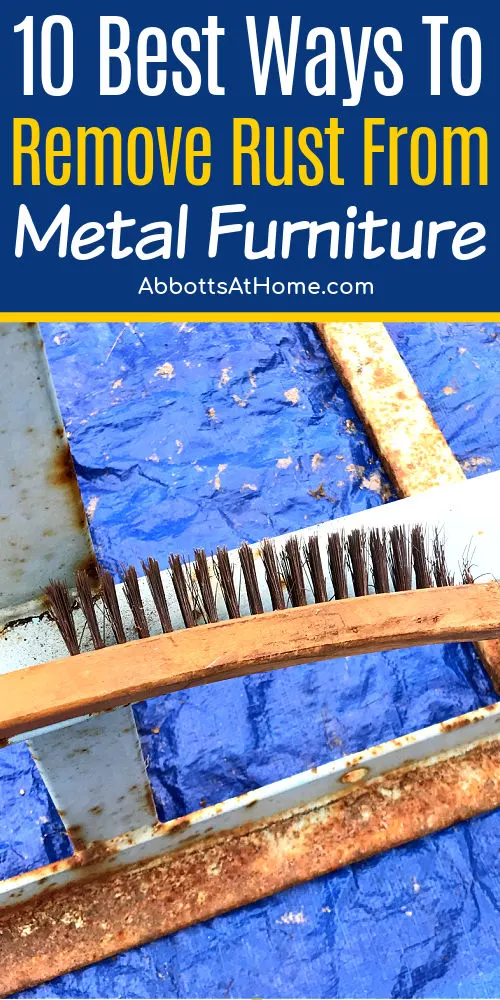
How to Paint Rusty Metal Furniture
If you had heavily rusted metal furniture, like I did, start with a good primer for rusty metal, like Rust-oleum Rusty Metal Primer.
If your metal furniture didn’t have much rust, you can skip the separate primer. Use Rust-oleums Universal Paint & Primer in One to give your metal furniture a beautiful new look.
I used 4 or 5 cans total on this small rusty table. Be sure to always follow the instructions and drying guidelines for the spray paint you use.
That’s it! That’s how to remove rust from metal furniture!
More DIY Projects For You
- Fix Your Rusty Dishwasher Rack: Super Easy DIY Steps & Video
- How To Use Easy Off Oven Cleaner Fume Free (Easy Steps, Tips, FAQs & Video)
- 18 BIG Pros & Cons: Should You Paint a Brick House White
- Is It Cheaper To Build Your Own Swing Set? (Cost of DIY vs Kits)
- 5 Best Ways to Remove Dried Citristrip on Furniture and Wood: Easy DIY
- Best Way To Stain An Exterior Wood Door: Easy Steps, FAQs, And Tips
Looking for more easy Home Improvement Projects? Here’s how I clean and whiten my grout when it starts looking too grungy.
You might also like How to Remove Water Stain from Ceiling Without Paint – 1 Easy Step.
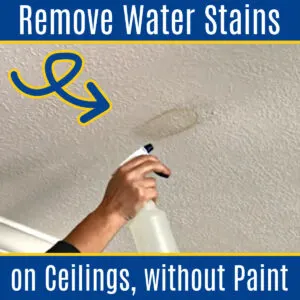
Or this post on the 16 Great Ways to Repurpose an Open Formal Living Room.

Feeling inspired? Now you know how to remove rust from metal furniture. Have fun and let me know if you have questions.

Stephanie Abbott has been remodeling homes, updating & building furniture, and working on DIY home maintenance and cleaning tips for over 20 years. Her remodeling has been featured in Better Homes and Gardens Magazine. And, her DIY YouTube channel has had more than 8 million views.
Most of the DIY tutorials and videos on this site focus on beginner to intermediate level DIY Projects that can be done in an affordable way without high-end, expensive tools. All of the cleaning tips on this website have been tested in her home.


nicola hopwood
Monday 15th of October 2018
how did you get the rusty bolts off? I am redoing my picnic tables and I am trying to replace the bolts but they are rusted so they just keep spinning and I dont know how to keep the top from spinning so I can loosen them.
Stephanie
Monday 15th of October 2018
Without seeing it, it's hard to say the best way to go. But here are a few ideas. If there aren't any nuts, try hammering from the back side. If they're just spinning the threads or the opening might be rusted enough to hammer the bolt out. Or, if you can cut part of it off with a bolt cutter, that might help. Or, try clamping on to the bolt with strong pliers and pulling while unscrewing. You might need something like a rubber band between the bolt and pliers to make it really hold on tight to that bolt. Or, a drill bit for metal might be the last resort. Maybe a combo of drill bit and bolt cutter. Good luck!!!
JESS44903
Wednesday 11th of October 2017
Great tips! :)
I would love for you to share this with my Facebook Group for recipes, crafts, tips, and tricks: https://www.facebook.com/groups/pluckyrecipescraftstips/
Thanks for joining Cooking and Crafting with J & J!
harropaj
Monday 9th of October 2017
What a great job at restoring it to it's former glory and I am the same with sick plants I hate to see them just left and feel the need to rescue them
Stephanie
Monday 9th of October 2017
Thanks! Now that's a real talent. I never feel like I can save a sick plant. :)
acraftymix
Saturday 7th of October 2017
Lovely restore Stephanie. It's amazing what a little elbow grease and time can do. The table will be good for many more years
Stephanie
Sunday 8th of October 2017
Thanks. I’m so glad I spotted it under all the recycling and scrap. :)
Amy@HighstyleRestyle
Friday 6th of October 2017
What a great find a beautiful save!